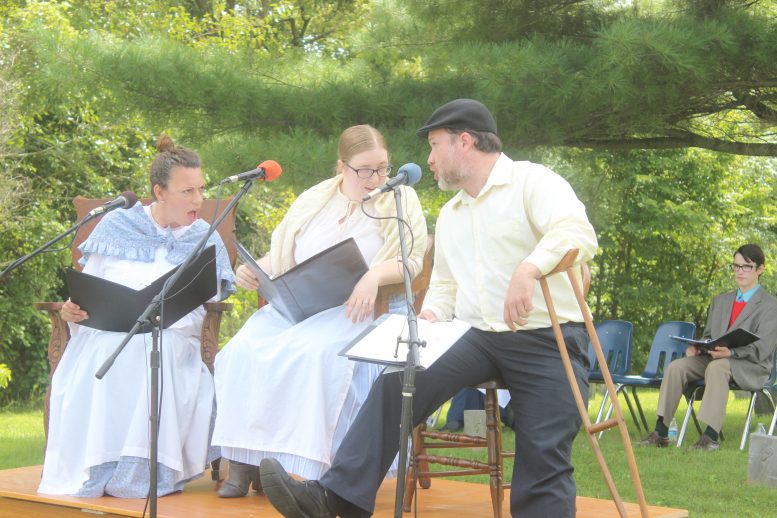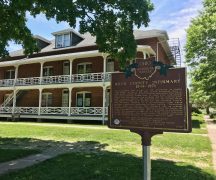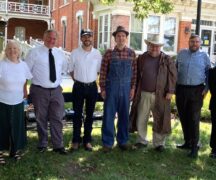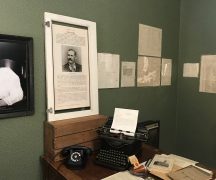By DAVID DUPONT
BG Independent News
Catherine Andelfinger and Sally Legron sat down for a gab on Sunday afternoon.
Both women were residents of the Wood County Home for many years, so they had lots to gossip about, especially their fellow residents.
Catherine and Sally couldn’t be there themselves. Both have been dead for a century or more. Their remains were among the more than 250 interred in the Paupers’ Cemetery on the grounds of the Wood County Historical Museum.
So in order to chat, they needed some help — September Killy provided the voice for Andelfinger and Cassie Greenlee spoke for Legron.
The actresses sat with the cemetery to their backs and welcomed figures from the past who had found their final resting places there.
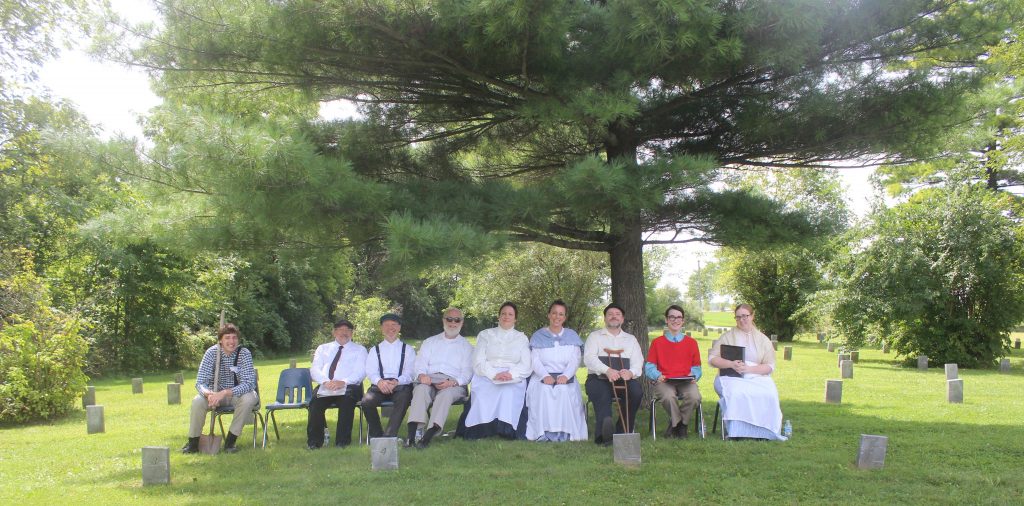
This was a new location and different format for the Wood County Historical Society’s Living History Day. The usual home for the annual event is Oak Grove Cemetery. And instead of a series of actors speaking the stories of past county residents, here the tales were told through conversation, a necessary adaptation given the scarcity of biographical detail of the people portrayed.
These were not prominent folks who wrote letters, or kept journals, or who were written about extensively in the local newspaper. Nor did they have descendants eager to share their story.
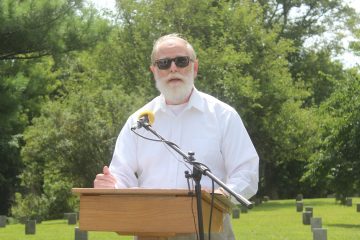
Holly (Hartlerode) Kirkendall, the curator of the museum, introduced the proceedings. She said the Wood County Library’s recent effort to digitize newspapers from the county provided invaluable help to Millie Broka as she researched these subjects.
Drawing on the obituaries found there, Kirkendall gave a sense of the folks whose life circumstances led them to the county home. Hard times drove them here. Maybe they were lame or infirm. Maybe they were women abandoned by their husbands. Many were folks who never strayed from Wood County. Others found their way here from afar, including Hungary, Switzerland, and Italy. At least one man who’d been enslaved in Virginia was buried here.
Frank Brandeberry came as a teenager, explained Keith Guion. He fell in love with Lottie, the daughter of Edwin and Charlotte Farmer, who acted as superintendent and matron from 1878 to 1904.
When the Farmers retired, Brandeberry and Lottie, now his wife, assumed those roles and served until 1948. A wall-size photo of Brandeberry in his prime pushing a wheelbarrow of produce grown on the property graces the exhibit “For Comfort and Convenience: Public Charity in Ohio by Way of the Poor Farm,” on display at the museum through December. The Living History program was presented at the museum in conjunction with the exhibit.
Brandeberry introduced Katherine and Sally, and they in turn introduced the listeners to a handful of the colorful characters who lay at rest in the surrounding graveyard. “Think of us as living memories,” he said.
Katherine herself was one such character. She lived in the home for 30 years, but was known to wander off on occasion. Only for a few days, she said, and she always returned.
That’s why she was known, Sally said, as “Old Mother Come and Go.”
Andelfinger is the only person in the Paupers’ Cemetery to have her own tombstone. The widow of a Civil War veteran, she saved her husband’s pension to make sure her grave was marked. No one knows who lies under the other numbered tombstones.
Sally was known for smoking a pipe and liking her coffee strong and hot.
Mary Elizabeth Rhodes came as an unwed mother rejected by her family for being “contrary.” Her infant daughter was sent away to a children’s home near Cleveland, and her mother heard nothing more of her.
That was for the best, she said. “At least that’s what I told myself.”
Her extended family moved away, but Rhodes “found a home here” where she lived for 50 years, dying in 1933.
George Bice (Thomas Edge) had a wooden leg, and a tangled marital life. His wife abandoned him and their five children, and then returned and demanded custody of the children. Bice fought it, and maintained custody. He eventually went to live with his daughters after a short stay at the county home.
Fleeing from the looming prospects of war, Frank Rakovan came from the part of the Austro-Hungarian Empire that became Czechoslovakia. He ended up in Rossford working at the Edward Ford Glassworks. It’s uncertain why he ended up in the infirmary, dying in 1938. He left a long line of relatives.
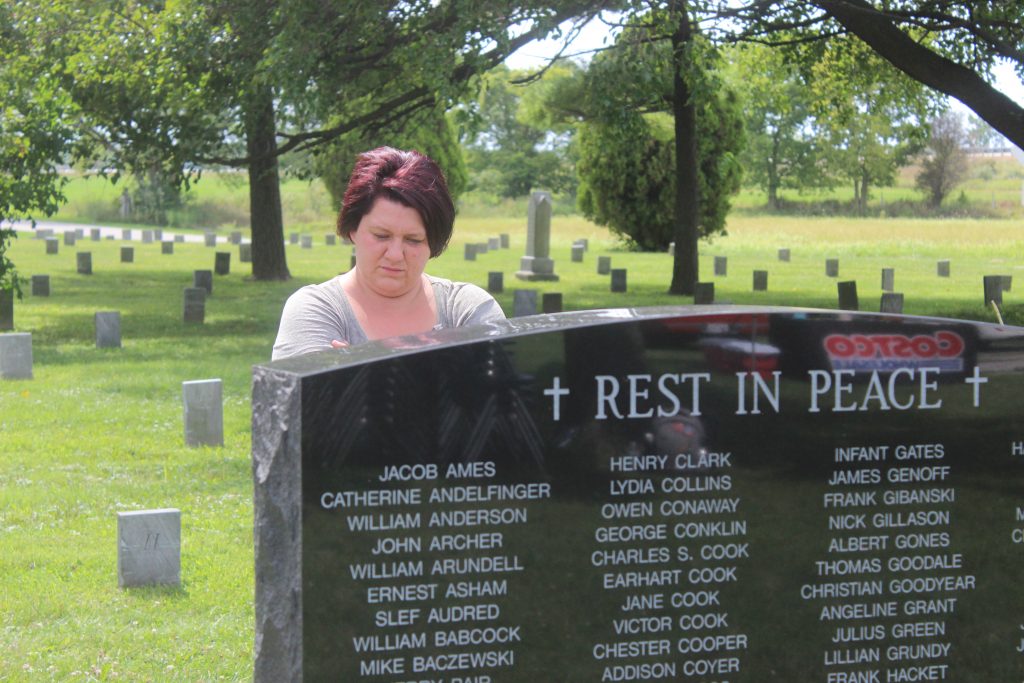
Not all buried in the Paupers’ Cemetery lived in the county home.
There was the “unknown man,” a young man found stabbed dozens of times and dumped, probably still alive, in an oil field on Jan. 3, 1941.
Bob Walters portrayed him, teasing out the few known facts, and dodging around the many mysteries. The Deck Funeral Home didn’t bury him for months just in case someone could identify him. Asked if he could name his killers, Walters speaking for the unknown man, said he would not, for fear they could get him even beyond the grave.
Arthur Palmer Moore (Geoffrey Howes) also met a violent end. In 1927, he was shot by a gas station owner who confronted him and his brother-in-law because they were driving the local bank president’s car.
Moore admitted he “fell in with some bad people.”
Most of them were related to his wife.
Asked if they had stolen the car, Moore replied: “It’s entirely possible.”
No one wanted him buried in their cemetery so he came to rest with the residents of the county home.

